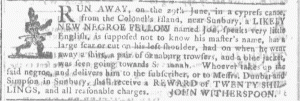Who was the subject of an advertisement in a colonial American newspaper 250 years ago today?

“RUN AWAY … NEGROE FELLOW named Joe.”
Joe, “a LIKELY NEW NEGROE FELLOW,” made a run for it in the summer of 1767. At the end of June, he took a canoe and attempted to make his escape from John Witherspoon. The slaveholder stated that the fugitive “was seen going towards Savannah,” perhaps heading for Savannah from Sunbury, perhaps heading toward the largest settlement in the area in hopes of attracting less attention among larger numbers of people. It may have been hard for Joe to avoid detection, however, because he “speaks very little English.”
Among enslaved men and women in Georgia, Joe was not alone in desiring his freedom. In another advertisement, David Cutler Braddock reported that his slaves had “TAKEN UP … a CANOE with TWO RUNAWAY NEGROES, a man and a woman.” Braddock advertised that he would hold the canoe until its owner came to collect it. “The negroes,” on the other hand, “were sent to the work-house” (where they joined Sharper and Tom, two captured runaways listed in the final advertisement in the July 15 issue of the Georgia Gazette).
These brief advertisements told intriguing yet incomplete stories about enslaved men and women. In addition to noting that he spoke little English, Witherspoon described Joe as “NEW.” How long had he been in Georgia? Had he recently survived the Middle Passage from Africa to the Americas? Given that he was headed toward Savannah, how familiar was he with the local geography? Did he hope to reunite with friends or relatives there? Or was he on his own? What was the source of the “large scar or cut on his left shoulder”? Was it the result of some sort of punishment that may have strengthened his resolve to make an escape?
How about the runaways in the canoe? What was their relationship? Husband and wife? Brother and sister? Friends or acquaintances connected by little more than their bondage and mutual agreement to seized an opportunity to take a canoe and depart when no one was looking? What role did Braddock’s slaves play in capturing them? What was their motivation for the part they played? Did they participate willingly? Did they turn in the runaways because they expected some sort of reward? Did they turn over the fugitives and their canoe to the slaveholder reluctantly only to avoid trouble because others observed them?
Advertisements for runaway slaves have been called the first slave narratives. They certainly tell important stories about the agency exercised by enslaved men and women, but since slaveholders composed them they lack some of the perspective and insight that likely would have been present in first-person narratives. These advertisements tell rich stories, but the questions they raise can sometimes be as revealing about the experiences of enslaved people in colonial America.
